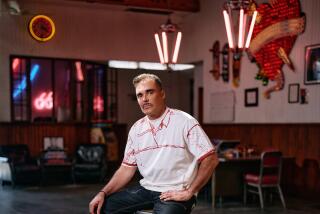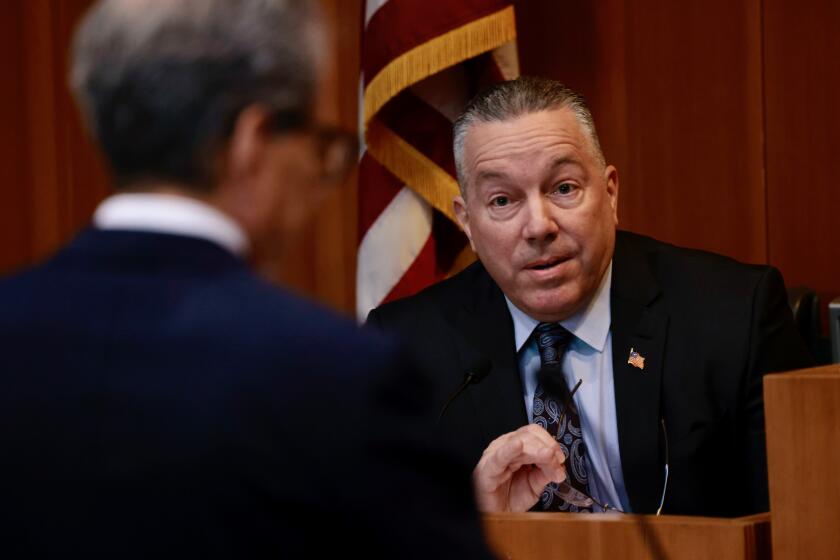Paparazzi Flash New Audacity
- Share via
Mischa Barton, the doe-eyed star of “The O.C.” television series, stepped into the Lisa Kline boutique, leaving a pack of paparazzi outside on the sidewalk.
Employees dropped the Robertson Boulevard store’s “paparazzi curtain,” a motorized black drape installed to shield celebrities from view. Undaunted, paparazzo Todd K. Wallace repeatedly barged into the store, over assistant manager Joanna Schroeder’s objections, according to an application for a restraining order she later filed.
Wallace, who prosecutors in court records said has used a dozen aliases and who spent four years in prison for burglary and petty theft, yelled obscene threats at Schroeder, she said.
When she finally got him to leave, Schroeder watched Wallace bang his truck into cars behind and in front of his parking spot, she said in an interview.
The incident was more than a year ago, but there’s little evidence that Wallace has changed his ways. He was charged Oct. 7 with battery and child endangerment for allegedly disrupting a summer outing to a theme park by actress Reese Witherspoon and her children.
Wallace, accused of striking one child with a camera and driving another to tears, denied the charges, saying he was the victim of an anti-paparazzi vendetta by “Hollywood power brokers.”
Authorities and celebrities, however, say a new breed of photographer is injecting a heightened level of danger and aggression into the duel between celebrities and those who make big bucks off their photographs.
One of the new paparazzi agencies is named for the Los Angeles street gang that the owner belonged to as a teenager; he said he trains other reformed gang members in the business.
Other agencies use foreigners working on what some say are questionable visas. Photographers are hired less for their camera skills than their ability to navigate the rough-and-tumble of the celebrity chase, authorities say.
“One of the reasons some of the other agencies dislike the way we work, we have been willing to hire anyone, people without previous photography experience,” said Kelly Davis, who helps run X-17, one of the agencies that other paparazzi say employ more aggressive tactics.
The trend is fueled by a global explosion in celebrity photo magazines, which can pay $100,000 or more for a single shot. The local cadre of paparazzi has grown from a couple of dozen to more than 200 over the last five years, ratcheting up the competition.
“It’s each one for their own,” paparazzo Marc Rylewski said. Paparazzi “race each other, jockey for position and block each other on the road.”
Some drive rental cars, obscure their license plates or use aliases to hide their identities or connections to the big agencies that control much of the market.
“Looking back at how this has evolved over the last 12 years, we’ve gone from guys who sit outside the home of the mother-to-be of Michael Jackson’s children to the paparazzi willing to force celebrities off the road for a photo and public safety be damned,” said Los Angeles Police Det. Jeff Dunn, who oversees the department’s Threat Assessment Unit.
Francois Navarre, a Frenchman and former Le Monde journalist who heads X-17, said he uses only freelancers, guys with streets smarts and connections such as former San Diego-area firefighter Brad Diaz, who was shot with a BB gun outside Britney Spears’ baby shower in Malibu this summer.
“We respect the rules of the community ... not the laws or rules that these [old guard] guys created,” Navarre said. “There’s no priority for the old paparazzi.”
Arnold Cousart made the leap from processing film for paparazzi to starting his own agency, JFX Direct, which he named after the multi-ethnic street gang he belonged to growing up: Jefrox, a bastardization of a Filipino-based term that essentially means “the projects.”
“I like the idea of [the gang name] on checks instead of seeing it on the wall,” Cousart said. “We came from the streets. Basically everyone knows that. We’re all family guys now.”
Actress Scarlett Johansson blamed her August traffic collision on a JFX Direct paparazzo who she said chased her into the Disneyland parking lot. Cousart said the shooter was blocks away.
A third agency, Boris Nizon’s Fame Pictures, was involved in the most notorious paparazzi incident of the year: Lindsay Lohan’s collision with a paparazzo.
Fame Pictures shooter Galo Ramirez was arrested in May on suspicion of assault after Lohan accused him of deliberately ramming her Mercedes-Benz sports car with his van. The agency, through its lawyer, insisted that the collision was an accident. Ramirez’s van was registered in Nizon’s name, prosecutors said.
“If Lindsay wasn’t driving a $200,000 car that day, we’d be looking at more than cuts and bruises,” said Blair Berk, her attorney.
Spurred by that crash, Gov. Arnold Schwarzenegger signed a bill this month making it easier for celebrities to collect major damages from agencies that employ aggressive paparazzi.
The Los Angeles district attorney’s office is looking into possible conspiracy charges against the confrontational agencies.
“It’s getting ugly out there,” said Deputy Dist. Atty. William Hodgman, who is heading the investigation.
But a previous anti-paparazzi bill, passed after British-born shooter Giles Harrison was convicted in 1998 of trapping Schwarzenegger, in his pre-governor days, and his wife, Maria Shriver, outside their son’s preschool, proved ineffective, authorities say. The bill targeted trespassing by paparazzi.
Witherspoon, one of Hollywood’s most outspoken critics of paparazzi, said she first noticed the more aggressive shooters in 2001.
“I have no less than six photographers every day on me,” she said. “They are in rapid pursuits. There are all sorts of illegal driving going on that endangers everyone around them.
“We’ve had to move houses, we moved schools and we sell our vehicles every two months,” she said. “Even then, they seem to get the car information from the dealership. They have networks that are like spider webs.”
Witherspoon blamed the bad behavior on the magazines that buy invasive photographers’ work. Larry Hackett, deputy managing editor of People, who said his magazine has a “tenet” against running intrusive photographs, agreed.
“I can’t stop these guys taking these photos. But I can decide not to buy them,” he said.
Immediately after the Lohan crash, Us Weekly issued an ethics policy stating that editors would refuse to run pictures taken by overly aggressive or intrusive photographers. Editor Janice Min, through a spokesman, said she would not comment.
Paparazzi respond that stars exaggerate what amounts to at worst an inconvenience.
“We are scapegoats in all these incidents. Blame the paparazzi when anything goes wrong,” said JFX co-owner Cousart.
“I have at least five stars this year who contacted us through their publicists to buy prints of pictures we took,” Navarre said. “Is that not funny?”
Frank Griffin is co-owner with Randy Bauer of the Bauer-Griffin Agency, one of the more established and respected firms. In one breath he lamented the influx of “guns for hire” that have added a “renegade element” to the trade. In the next he said he pays law enforcement for information on celebrities.
The officers may be breaking the law. Los Angeles Police Officer Kelly Chrisman was fired in 2003 for allegedly using department computers to look up confidential law enforcement information on scores of celebrities. He said he was authorized by his supervisors to look up the information for a security database.
Rival paparazzi say Navarre’s X-17 shooters travel in SUV convoys, communicating by cellphones and two-way radios.
“They’re almost like a pack of wolves,” said JFX’s Cousart. “Eight guys out there to get one picture.”
Two years ago, Navarre paid actress Jennifer Aniston $550,000 to settle an invasion-of-privacy lawsuit over photos of her sunbathing topless in her backyard. In the settlement, he admitted no wrongdoing. The photo was allegedly taken from a neighbor’s yard. Navarre said in court documents that he brokered the picture from “a French tourist.”
He said other paparazzi question the immigration status of his shooters because they are jealous of his success.
“There are a lot of paparazzi that are in the process of being legal,” he said. “I consider it racism or xenophobia; this guy, because he’s from Africa or because he’s from Europe, he’s illegal. They haven’t checked.”
Paparazzo Rylewski, another Frenchman, once freelanced for X-17. A year ago, he took a Playboy writer on a ride-along and promptly crashed into another car, the magazine reported.
Over an eight-year career in Los Angeles, Rylewski has been convicted of trespassing and spent 30 days in jail for hitting rival paparazzo Stephen Ginsburg. Ginsburg described Rylewski as his paparazzi mentor.
Rylewski was deported Aug. 12 for overstaying his visa, which had expired six years earlier, immigration officials said. Many paparazzi in Los Angeles work on tourist visas, Rylewski said.
It’s a legal gray area, said John Taussig, an immigration lawyer: While they can work here for businesses based in a foreign country, they cannot be paid by U.S. employers for jobs performed in America.
“Most of them try to get their agency to bring them for three months and then get a plane ticket so they can go back into their country and get another three-month visa,” Rylewski said in a phone interview from Paris, where he was on his way to Russia to shoot “very anti-American films.”
JFX Direct’s Cousart said he is proud of mentoring other former gang members as paparazzi.
One of them, Gerard San Jose, was sentenced to the California Youth Authority in 1992 for shooting into a passing car. “It’s quite clear that this defendant had the intent to kill these kids and that he just got lucky,” a prosecutor told the court, according to trial records.
“I did five years for that,” said San Jose, now a father of three, who went on to work for Bauer-Griffin. “Unfortunately, I was a product of my environment: single-mother household. My father died when I was 9.”
Upon his release, San Jose got the conviction removed from his record.
“A low-key, stealth-like approach works for me,” said San Jose, who now works for himself. He said he got the first shot of Angelina Jolie’s son, Maddox.
San Jose’s Jefrox gang name was “Dreamer.”
Despite all the complaints, the heightened aggression cannot be blamed solely on a new generation of paparazzi.
Giles Harrison, a 10-year veteran paparazzo, goes on trial in November on felony assault charges. Authorities allege that he beat rival Tomas Maidana outside the Ivy restaurant in a dispute over photographing director Quentin Tarantino. Harrison, who a pretrial report says makes $30,000 to $40,000 a month, denies the charges.
On a videotape of the fight, Harrison and Maidana can be heard trading slurs. Harrison yells, “Take the boat back to Cuba!” and Maidana responds with a racial epithet. Harrison punches Maidana in the head, then tries to kick him. Maidana darts into the street, removes his belt and invites Harrison into the alley.
Harrison sued, alleging that Maidana instigated the fight. He later withdrew the complaint.
“Everybody knows I’m a nice guy,” the 6-foot-8, 280-pound paparazzo said in a recent interview. “Three incidents in 10 years of doing this business; that’s not too terribly bad, I’d say.”
More to Read
Sign up for Essential California
The most important California stories and recommendations in your inbox every morning.
You may occasionally receive promotional content from the Los Angeles Times.











